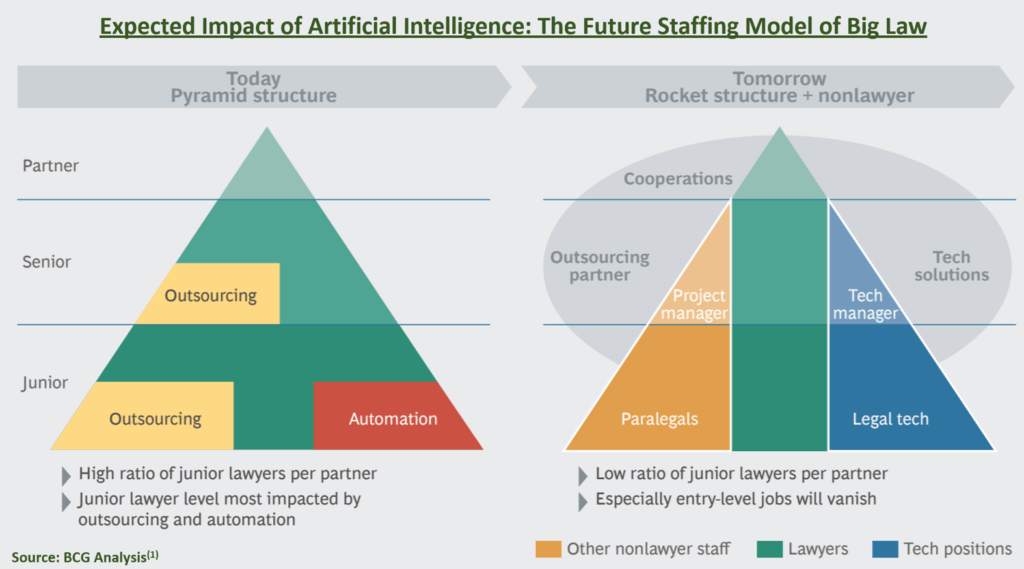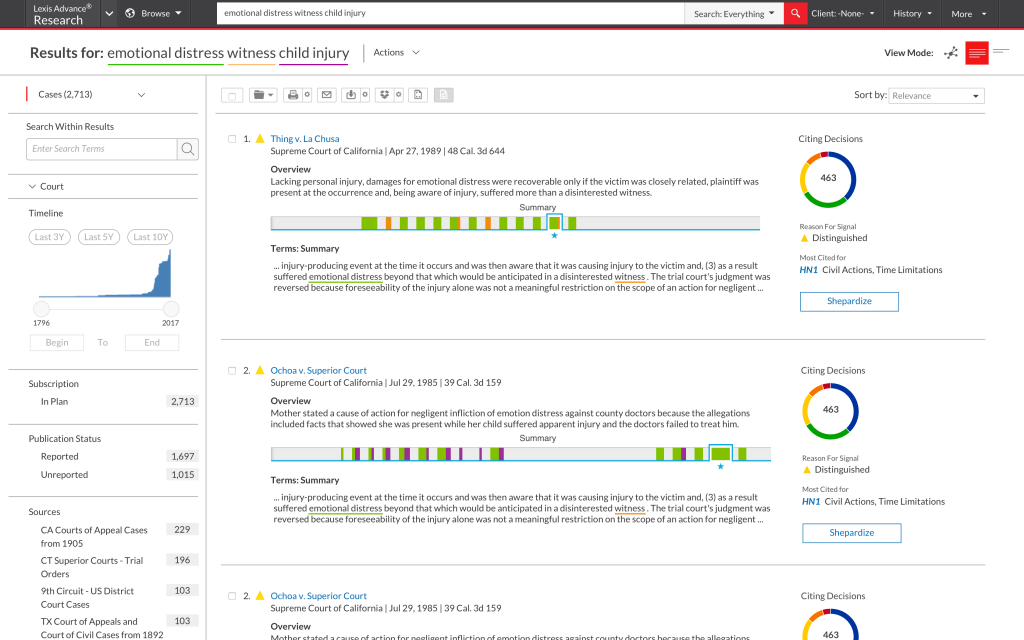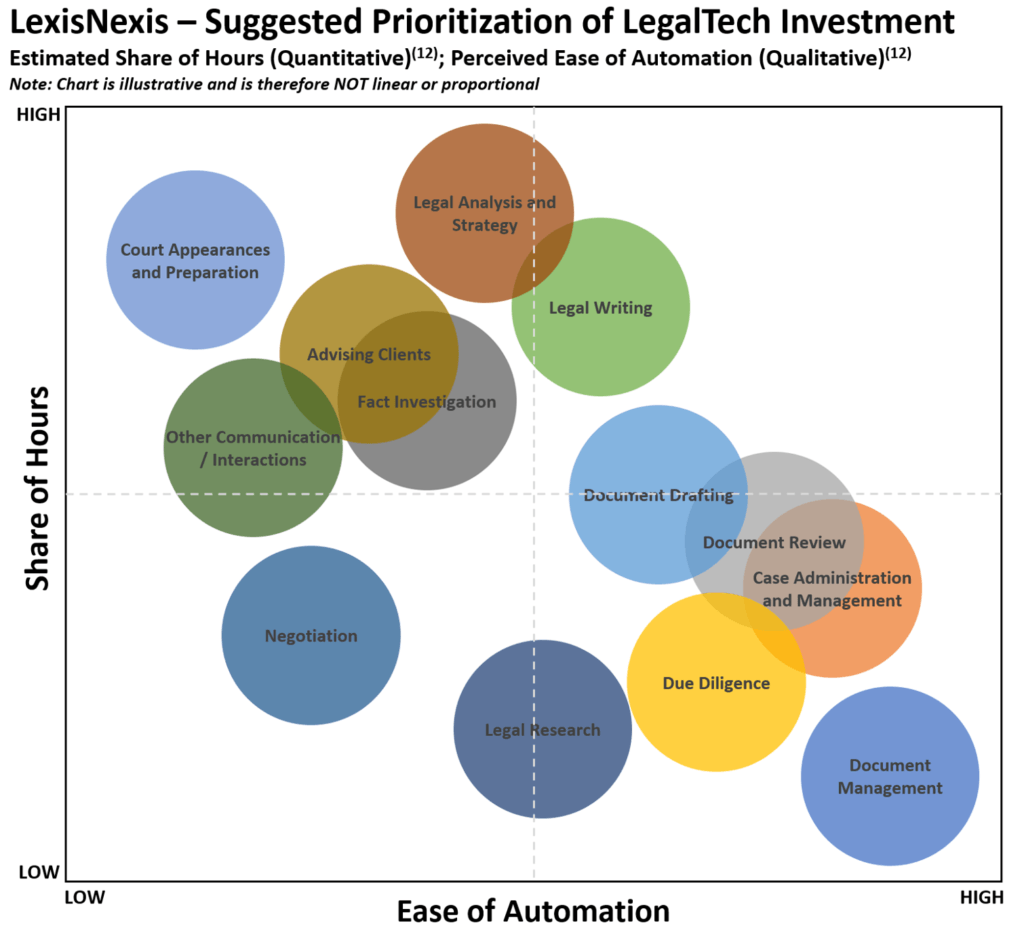LexisNexis and LegalTech: Automation of Legal Services

Most discussions of job automation tend to focus on relatively unskilled labor – self-driving cars, factory automation, etc. However, companies applying technology toward the automation of white collar jobs are gaining traction – this piece examines progress in the Legal Services market.
“The digitization of legal data constitutes [a] megatrend transforming workflows and business models. The volume of data used in legal advice has increased exponentially… In the future, the ability to screen, analyze, and interpret unprecedented volumes of data will become just as critical to law firms’ success as the “art” of delivering legal advice is now… The use of technology solutions to handle standard, low-skill legal tasks could reduce the ratio of junior lawyers to partners by up to three quarters of the ratio seen in the current pyramid model”
– How Legal Technology Will Change the Business of Law, BCG & Bucerius Law School(1)
Introduction to LexisNexis
LexisNexis is one of two leading providers of computer-assisted legal research—the company’s mission is to “help lawyers increase productivity, improve decision-making and outcomes, and generate value for their organization”(2). Founded in 1970, the company pioneered the electronic accessibility of legal and journalistic documents(3). Today, LexisNexis offers a suite of products, including a widely used “search engine” for case law, advanced templates for legal documents, practice management software, and other tools for the professional legal market. The company’s product portfolio incorporates over 30 terabytes of content, representing the world’s largest electronic database for legal and public-records related information(4).
As illustrated in this essay’s opening quote, industry participants have begun to realize the potential value that data, analytics, and artificial intelligence can bring to the legal industry; while we’re likely years away from the transformative impact predicted by BCG, increasing venture investment (>$350M invested from April-Sept 2018, compared to ~$100M in full year 2010 (5)(6)(7)) and corporate interest in LegalTech are bringing products to market that offer law firms significant advantages in terms of efficiency and capability. Given the realities of this environment, LexisNexis has a choice: innovate or be left behind by more progressive challengers.
Product Snapshot: Lexis Advance (case law search engine / LexisNexis’ most widely used product)
Developing Legal Technologies
LexisNexis has continued its legacy of innovation through significant organic and inorganic investment in machine learning, natural language processing, and other artificial intelligence technologies.
Example 1 – Organic Investment / Internal Product Development: In 2017, LexisNexis introduced the Lexis Answers feature to the company’s case law search engine (the company’s most widely used product—marketed as ‘Lexis Advance’). While legal research tools have historically been limited to basic search results and standard Boolean logic(8), Lexis Answers uses machine learning and natural language processing to add three major improvements to the Lexis Advance product: A) search queries can be framed as standard English-language questions (e.g., “what is the definition of joint tortfeasor?”), B) search results more accurately predict the most relevant, comprehensive, and clear results for each individual user (based on the user’s query, firm, search history, and other data), and C) search queries are dynamically anticipated / suggested to the user(9).
Example 2 – Inorganic Investment / Acquisition of New Technologies: LexisNexis has made a number of acquisitions aimed at enhancing the company’s technological capabilities, including Lex Machina (in 2015)(10) and Ravel Law (in 2017)(11). LexisNexis has used the technology acquired through these deals to expand its case law database, improve the functionality / efficiency of its core products (e.g., improving search results), and provide end-users with computer-generated predicted outcomes for various legal strategies (taking into account a wide range of factors including historical case results, presiding judges, competitive intelligence on opposing parties, witness credibility, etc.)(10)(11). These functionalities provide customers with immediate, differentiated insight, and although current predictive capabilities are somewhat limited, the value proposition to customers will likely increase as these technologies improve and penetration/adoption rates increase.
The Future of Efficiency and Automation in Law
LexisNexis should continue investing heavily in new technologies, both through internal product development and selective acquisition. In the short-to-medium term, LexisNexis should focus its product development efforts on areas that A) represent a large percentage of lawyers’ invoiced hours, and B) allow for relatively straightforward automation. The graphic below outlines a high-level framework—product development opportunities addressing tasks in the top right quadrant, such as Legal Writing, represent the most attractive short-to-medium term opportunities. However, technologies that address the bottom right quadrant may still represent important short-term opportunities, and the top-left quadrant represents the highest value projects in the long-term.
Rapidly increasing venture / corporate funding and quickly improving technologies have peaked the interest of industry stakeholders, however many questions remain. To what degree, and how soon, will artificial intelligence automate the more complex workstreams performed by Big Law (e.g., Negotiation, Legal Analysis and Strategy)—will these technologies extend beyond standardized / basic workstreams? How slowly / rapidly will consumers adopt these technologies?
(753 words)
Appendix
References
- Bucerius-education.de. (2016). How Legal Technology Will Change the Business of Law. [online] Available at: http://www.bucerius-education.de/fileadmin/content/pdf/studies_publications/Legal_Tech_Report_2016.pdf [Accessed 9 Nov. 2018].
- Lexisnexis.com. (2018). About Us – LexisNexis. [online] Available at: https://www.lexisnexis.com/en-us/about-us/about-us.page [Accessed 9 Nov. 2018].
- Miller, S. (2012). For Future Reference, a Pioneer in Online Reading. [online] WSJ. Available at: https://www.wsj.com/articles/SB10001424052970203721704577157211501855648 [Accessed 9 Nov. 2018].
- UPI. (2012). Lexis-Nexis founder Don Wilson dies. [online] Available at: https://www.upi.com/Lexis-Nexis-founder-Don-Wilson-dies/36121164992489/ [Accessed 9 Nov. 2018].
- Ambrogi, R. (2018). $200M In Two Months Says Investors No Longer Snubbing Legal Tech. [online] Above the Law. Available at: https://abovethelaw.com/2018/07/200m-in-two-months-says-investors-no-longer-snubbing-legal-tech/ [Accessed 9 Nov. 2018].
- Packels, S. (2018). Venture Capitalists Pour Another $115M into Legal Tech Platforms | The American Lawyer. [online] The American Lawyer. Available at: https://www.law.com/americanlawyer/2018/09/11/venture-capitalists-pour-another-115m-into-legal-tech-platforms/ [Accessed 9 Nov. 2018].
- O’Keefe, K., Reuters, T. and Reuters, T. (2017). Investment In Legal Tech Is Slowing While Legal Tech Is Booming. [online] Above the Law. Available at: https://abovethelaw.com/2017/11/investment-in-legal-tech-is-slowing-while-legal-tech-is-booming/?rf=1 [Accessed 9 Nov. 2018].
- Clelaw.lib.oh.us. (2011). BOOLEAN SEARCHING. [online] Available at: http://www.clelaw.lib.oh.us/Public/Misc/Boolean%20Searching.html [Accessed 9 Nov. 2018].
- Lexisnexis.com. (2017). You Ask. Lexis® Answers—new machine-learning feature on Lexis Advance. [online] Available at: https://www.lexisnexis.com/infopro/keeping-current/b/weblog/archive/2017/06/29/you-ask-lexis-174-answers-new-machine-learning-feature-on-lexis-advance.aspx [Accessed 9 Nov. 2018].
- LawSites. (2018). Exclusive First Look: Ravel Law’s Integration with Lexis Advance | LawSites. [online] Available at: https://www.lawsitesblog.com/2018/02/exclusive-first-look-ravel-laws-integration-lexis-advance.html [Accessed 9 Nov. 2018].
- Lex Machina. (2015). LexisNexis Acquires Premier Legal Analytics Provider Lex Machina. [online] Available at: https://lexmachina.com/media/press/lexisnexis-acquires-lex-machina/ [Accessed 9 Nov. 2018].
- Remus, D. and Levy, F. (2015). Can Robots Be Lawyers? Computers, Lawyers, and the Practice of Law. SSRN Electronic Journal.








On your question of speed, I think that this is one of those technologies that will be adopted very fast by the industry. However, I do think that adoption will be limited to highly repetitive, not-too-much value-added work, such as contract revisions. The tools are already available, not only from LexisNexis but also from many other providers that are already proving their efficacy. In a recent test, a ML algorithm beat 20 experienced lawyers in reviewing NDA contracts, both in speed and accuracy [1]. Leading law firms are incorporating these tools, but they won’t take displace lawyers from key client-facing and other strategic tasks.
A question to be raised is, how is LexisNexis positioned to compete in this industry? Does it have competitive advantages to succeed?
[1] https://www.techspot.com/news/77189-machine-learning-algorithm-beats-20-lawyers-nda-legal.html
This is an absolutely fascinating piece on how AI could help transform legal research. As a JD/MBA, I know that this topic is one that gets considerable attention at the law school. I wanted to raise a couple of interesting points from a seminar on this very topic:
1. To my mind, the value of machine learning in improving the legal research process is simply that its current state is so time-consuming, expensive and cumbersome. You, however, raised the very crucial point that in addition to allowing you to find relevant sources, machine learning could also be used to help craft strategies with the highest probabilities of success. This is a crucial difference between legal research and other research as there is often a clear ruling in a case- a binary yes or no, that can be used by machine learning to construct different legal approaches based on probable outcomes.
2. You explained that Lexis Answers allows for improved search capabilities. Namely, that it doesn’t simply search a database for matches, but should use natural language processing to parse the question and then deliver the most appropriate results. While important in the context of legal research, developing these capabilities is of much much broader interest to the world at large. It would revolutionize all search engines. My question is whether it is realistic to hope that Lexis Nexis will achieve great results in this area when governments and much larger companies like Google and IBM are dedicating billions of dollars to these problems.
3. One potential problem with the adoption of Lexis’ search products is precisely the amount it reduces legal research time. As this is a service being marketed to law firms primarily, it would drastically reduce the number of billable hours they are able to charge for their services. My question is how do you foresee compensation incentives, price competition and reduced complexity impacting the adoption of this technology? How do you see this playing out in different channels and different industries?
Thanks,
Gabe
This is super interesting… automating big law opens the door for creating efficiencies for fairly time consuming processes. Would love to find ways to automate some manual but necessary processes in every transaction such as automating NDAs. Interested to see how adoption looks as the value add is clear but some old-world industries are slow to change their behaviors especially with sensitive / riskier topics.